Enhancing Healthcare with Medical Voice Dictation Tools
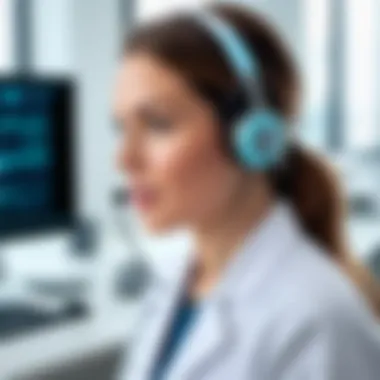

Intro
The integration of technology in healthcare is reshaping how professionals manage patient information. Medical voice dictation software stands as a significant advancement in this domain. Utilizing voice recognition technology, these tools streamline documentation processes, which is crucial for efficient patient care.
In this exploration, we will delve into the critical features of various voice dictation programs available, assess their impact on user experience, and consider their relevance to clinical workflows. The choice of such software can greatly affect both the productivity of healthcare practitioners and the quality of documentation they produce. This article will provide an essential overview, beneficial for tech-savvy individuals, business professionals, and IT experts looking for clarity in this evolving landscape.
Overview of Key Features
Understanding the features of medical voice dictation software is vital for making informed decisions. Healthcare professionals require tools that not only perform well but also integrate seamlessly into existing systems.
Essential Software Capabilities
- Voice Recognition Accuracy: High accuracy in converting speech to text is critical. Advanced algorithms and machine learning improve performance over time.
- Integration with EHR Systems: Compatibility with Electronic Health Records (EHR) is necessary to ensure that the dictated information is automatically filed where it needs to go.
- Multi-Device Functionality: Many providers offer applications for various devices, including desktop computers and mobile devices, allowing for flexibility in dictation.
- Customizable Vocabulary and Commands: The ability to add specific medical terms or commands enhances the software’s utility in specialized fields.
Unique Features That Differentiate Options
Different software options come with unique functionalities. Some may offer more specialized adaptations for particular fields such as surgery or radiology. Others may include built-in templates for certain types of documentation, a feature that can streamline the dictation process.
- Voice Command Options: Software like Dragon Medical One offers specific voice commands to navigate documentation more efficiently, setting it apart from others.
- Real-time Editing: Some applications allow for real-time text editing during dictation, making the process smoother and reducing time spent on revisions.
Effective voice dictation software can save healthcare providers significant hours each week, allowing them to focus more on patient care rather than paperwork.
User Experience
An optimal user experience is paramount when it comes to technology adoption in healthcare settings. Considerations that contribute to user satisfaction include interface design, ease of use, and the availability of support resources.
Interface and Usability
The user interface should be intuitive. A cleaner design with simple navigation encourages engagement. Users should be able to dictate without needing extensive training. Accessibility features can also enhance usability, making the software suitable for a wider range of users.
Support and Community Resources
A strong support system is essential for users who may face initial challenges. Many software providers offer tutorials, FAQs, and community forums where users can ask questions and share experiences. Helpful resources, such as those found on platforms like Reddit or Facebook groups, can be invaluable for troubleshooting and maximizing the software's potential.
Interactive expertise helps foster a sense of community, enriching the overall experience.
In summary, medical voice dictation software introduces transformative benefits but requires careful consideration of features, usability, and support. As healthcare continues to evolve, the role of such technology remains critical for enhancing efficiency and accuracy in documentation.
Prelude to Medical Voice Dictation Software
Medical voice dictation software is transforming the way healthcare professionals document patient interactions and clinical observations. In an era where time is of the essence, the ability to accurately capture and record information using voice rather than traditional keyboard methods presents numerous advantages.
Voice dictation enhances productivity. It allows clinicians to focus more on patient care instead of administrative tasks. Additionally, it can facilitate accurate documentation. The technology helps eliminate typos and miscommunications often associated with manual typing.
The relevance of this topic is underscored by the increasing demands on healthcare systems. As patient loads rise, and the need for timely records becomes more critical, voice dictation software emerges as a potential solution. This type of software is not just a luxury; it is quickly becoming a necessity to maintain effective patient management.
Furthermore, considering the variety of solutions available in the market, understanding their functionalities becomes vital for making informed decisions. Professionals need to assess features such as integration capabilities with existing systems, ease of use, and overall cost-effectiveness.
"The integration of voice dictation tools into healthcare workflows fundamentally reshapes the approach toward maintaining patient records."
The adoption of medical voice dictation software also engages with broader trends in technology, like the use of artificial intelligence and machine learning. These innovations aid in improving recognition accuracy and adapt over time to enhance user experience. It leads to a richer understanding of the potential impacts on workflow dynamics in clinical settings.
Understanding Voice Recognition Technology
Voice recognition technology forms the backbone of medical voice dictation software. It allows users to convert spoken language into written text, enabling a more fluid and efficient documentation process. This capability is especially relevant in healthcare settings, where the demands for precise and rapid documentation are ever-growing. Understanding how voice recognition works is crucial for healthcare professionals looking to leverage this technology effectively.
Basics of Voice Recognition
Voice recognition technology essentially relies on a systematic conversion of acoustic signals into text. When a user speaks, the software captures sound waves, processes them, and then analyzes the phonetic components.
This involves several steps:
- Audio Input: The initial step is the capture of spoken words through a microphone. Quality microphones ensure better clarity.
- Feature Extraction: This is where the software breaks down the audio into recognisable components, identifying unique characteristics of speech.
- Pattern Recognition: At this stage, the software matches the extracted features with known patterns in its database to decode the speech.
- Text Output: Finally, this matching process results in the conversion of spoken language into written text, ready for user review and editing.
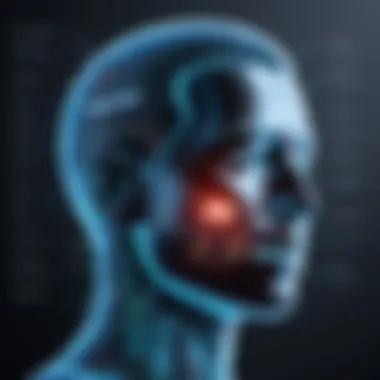
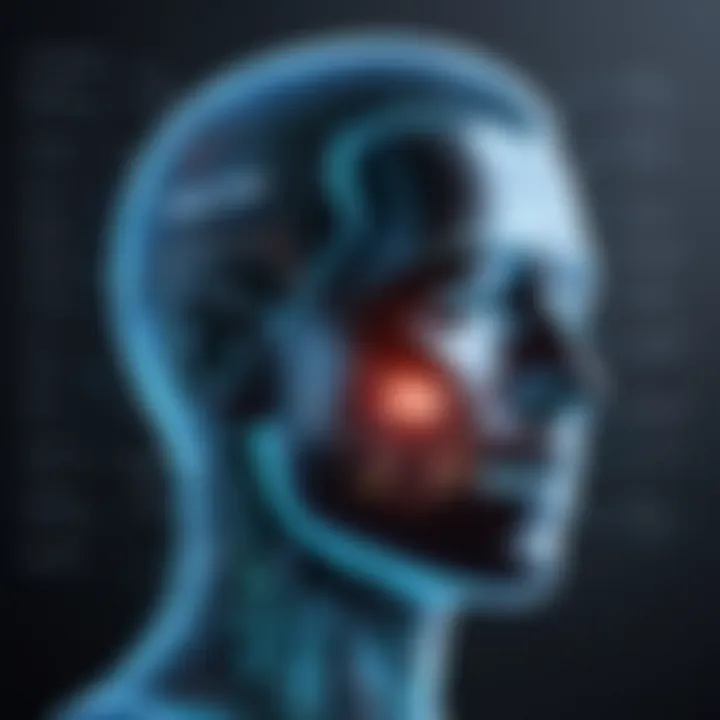
In clinical settings, accuracy in this process is essential. Voice recognition software needs to adapt to different accents, speech patterns, and terminologies specific to medical jargon.
Machine Learning and AI in Voice Dictation
Machine learning and artificial intelligence play pivotal roles in enhancing the functionality of voice dictation software. These technologies improve accuracy over time as they learn from user interactions. For instance, if a healthcare provider frequently uses specific terms, the software can learn these preferences and provide more accurate dictation based on past data.
Key benefits of machine learning in this context include:
- Adaptation: Continuous learning algorithms allow the software to adapt to individual speaking styles and vocabulary.
- Error Reduction: As the system learns, it becomes proficient at correcting common mistakes that may occur during transcription.
- Contextual Understanding: Advanced AI models can understand context better—like distinguishing medical terms based on patient records.
The implications of using machine learning and AI are significant. They do not just streamline documentation but also promote clinical efficiency. Providers can focus more on patient care instead of administrative tasks. This evolution in voice technology reflects the broader trend in healthcare towards increased efficiency and improved patient outcomes. Thus, understanding these technological foundations is vital for maximizing the potential of voice dictation software in medical practices.
Applications in Healthcare Settings
As healthcare shifts towards more efficient and streamlined practices, the role of medical voice dictation software has become increasingly crucial. This section underscores the importance of applications in healthcare settings, focusing on how these tools can enhance clinical practices, patient interactions, and telemedicine capabilities.
Clinical Documentation
In clinical settings, accurate and timely documentation is vital. Medical voice dictation software significantly reduces the time required to create patient records. Physicians can dictate notes faster than they can type. This not only enhances productivity but also allows for more comprehensive notes as clinicians can speak naturally.
Additionally, software solutions often have built-in templates for various medical specialties. These templates guide the documentation process. They help ensure compliance with legal and insurance requirements. Improved accuracy in documentation can minimize the risk of errors. This can lead to better patient outcomes. Furthermore, real-time transcription capabilities allow practitioners to update records during patient consultations, facilitating immediate data entry without interrupting the flow of care.
Patient Interaction
Engagement with patients is fundamental to successful healthcare delivery. Medical voice dictation software can enhance this interaction. By allowing clinicians to focus entirely on the patient rather than on typing notes, software fosters a more human connection.
Patients often appreciate when their healthcare providers maintain eye contact and actively listen to them. When clinicians use voice dictation, they can respond more intuitively to patient concerns. Consequently, patients may express greater satisfaction with their care experience. Moreover, some software solutions offer features for capturing patient feedback through voice commands. This additional layer of interaction can aid in understanding patient needs and preferences better.
Telemedicine Integration
With the rise of telemedicine, voice dictation software plays an essential role. The ability to document consultations efficiently is key for remote healthcare delivery. In virtual settings, clinicians can dictate patient notes just as they would in an in-person visit. This capability is crucial, especially when dealing with high volumes of patients.
Integration with electronic health records (EHR) systems is another significant advantage of voice dictation technology. It allows for smooth data transfer and ensures that all documentation is up-to-date. Furthermore, during telehealth sessions, the software can assist in summarizing key points discussed, leading to better continuity in patient care. As the future of healthcare continues to evolve, leveraging voice dictation in telemedicine can enhance functionality and enrich patient-provider interactions.
Key Benefits of Utilizing Voice Dictation Software
Voice dictation software has significant importance in the realm of healthcare, reshaping the way medical professionals manage documentation. The software provides various advantages across the workflow spectrum. It streamlines processes, reduces unnecessary delays, and aids in a comprehensive documentation strategy. The primary focus of this section is exploring three major benefits: increased efficiency, enhanced accuracy, and improved workflow.
Increased Efficiency
Utilizing voice dictation software leads to a remarkable boost in efficiency in document creation. Traditional methods of typing or handwriting notes can be time-intensive and prone to interruptions. By speaking rather than typing, healthcare providers can save valuable time during patient consultations or rounds. This time-saving aspect allows professionals to focus on patient care rather than getting bogged down by time-consuming documentation tasks.
Moreover, the software can work in real-time, meaning that notes can be generated almost instantaneously. This immediate documentation can lead to faster turnaround times for medical records. As a result, healthcare facilities are better equipped to manage workloads, facilitating improved patient care.
"Improved efficiency is not just about speed; it’s about creating more time for patient interaction and care."
Enhanced Accuracy
Accuracy in medical records is vital. Voice dictation software leverages advanced algorithms and machine learning to transcribe spoken language into text with greater precision than manual data entry. This capability minimizes the risk of typographical errors and misinterpretations that can occur during human transcription. The software can recognize medical terminology and various accents, thus reducing misunderstandings and ensuring that information is documented accurately.
Errors in documentation can lead to dire consequences in healthcare settings, such as incorrect treatments or medication issues. By employing voice dictation tools, healthcare providers can bolster the reliability of their records, ultimately promoting safer patient outcomes. Enhanced accuracy not only benefits immediate clinical practices but also strengthens institutional credibility.
Improved Workflow
Voice dictation software facilitates an improved workflow in various healthcare settings. By integrating seamlessly with Electronic Health Records (EHR) systems, it allows for a smoother transition of information from verbal notes to digital records. This integration enhances data accessibility for medical teams, ensuring that necessary information is available when needed, and streamlining the overall operation of the healthcare facility.
Furthermore, the software supports multi-tasking capabilities. Medical professionals can add voice notes about a patient while examining them or conducting procedures, preserving workflows that typically break for note-taking. This dynamic approach leads to more cohesive healthcare delivery since all information is up-to-date and readily available. The net effect is a synergy between documentation and clinical responsibilities, forming a more holistic patient care experience.
Challenges in Implementation
The integration of medical voice dictation software into healthcare systems is not without its hurdles. As this technology attempts to revolutionize documentation processes, several challenges become apparent. Understanding these challenges is crucial for decision-makers, IT professionals, and healthcare providers aiming to successfully deploy these tools. Failing to address these challenges can hinder potential benefits.
User Adoption and Training
User adoption stands as one of the primary barriers in implementing medical voice dictation software. The effectiveness of this tools hinges not only on the technology itself but also on how well users can adapt to it. Training programs are essential. These will give users the skills necessary to operate the software efficiently.
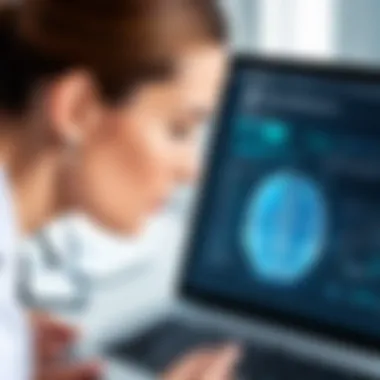
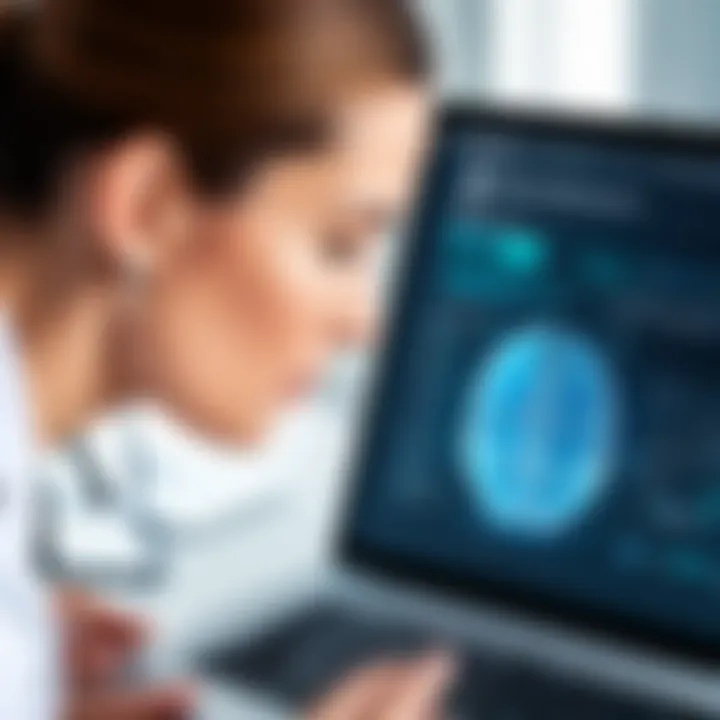
Effective training should encompass both initial sessions and ongoing support. Training should be tailored to different user groups, such as doctors, nurses, and administrative staff. Each group may have distinct needs and levels of technical ability.
Moreover, there is often resistance to change among healthcare staff. They may feel comfortable with existing documentation methods. Highlighting the advantages of voice dictation over traditional methods can ease this transition significantly.
Technical Limitations
Even the best voice dictation software comes with its technical limitations. These limitations can affect user experience and the overall effectiveness of the system.
One major concern is accuracy. Voice recognition technology is improving, yet it is not flawless. Different accents, background noise, and speaking speeds can introduce errors into transcriptions. This can lead to inconsistencies in medical records, which can have serious consequences in patient care.
Additionally, issues related to language support can be challenging. Not all software solutions support multiple languages or specialized medical terminology, which can limit its usability in diverse healthcare settings.
Integration with Existing Systems
Integration with existing healthcare systems is another significant challenge. Medical voice dictation software must seamlessly interact with Electronic Health Records (EHR) systems. This integration is vital to ensure that data flows smoothly and minimizes disruptions to clinical workflows.
Compatibility issues can arise if the software is not designed to integrate well with legacy systems. Healthcare providers may face costs related to updating or replacing outdated infrastructure, which can slow down implementation.
Another concern is data security. As voice dictation software captures sensitive patient information, it needs robust security measures in place. Any breach can not only compromise patient data but also lead to legal issues.
In summary, the successful implementation of medical voice dictation software relies heavily on overcoming challenges related to user adoption, technical limitations, and integration with existing systems. Addressing these issues is essential for maximizing the software's potential benefits.
Market Overview of Medical Voice Dictation Software
The landscape of medical voice dictation software has evolved significantly in recent years. Understanding this market is crucial as it directly influences healthcare documentation efficiency. The increasing adoption of voice recognition technology has prompted a wave of innovations and software solutions tailored for the medical sector. Therefore, a comprehensive overview assists healthcare professionals and decision-makers in identifying the right tools to enhance workflow effectiveness.
Top Software Solutions
Numerous voice dictation software solutions exist, each designed with specific functionalities catering to various healthcare needs. Dragon Medical One, developed by Nuance, remains a frontrunner due to its high accuracy and extensive vocabulary tailored for medical jargon. Another notable option is MediSpeech, which integrates seamlessly with existing electronic health records. Furthermore, Speechmatics offers robust transcription services powered by advanced AI, ensuring quick and reliable documentation.
It's essential to conduct thorough research on these solutions to determine which aligns best with the operational requirements of different healthcare environments. The choice of software impacts overall user experience and the quality of documentation processes.
Pricing Structures
When examining medical voice dictation software, pricing is a key consideration. These solutions tend to follow different pricing models, which can significantly influence budgeting for healthcare organizations. Subscription-based services are common in this space. For example, Dragon Medical One operates on a subscription model, allowing healthcare facilities to adapt financial commitments based on usage.
Conversely, one-time purchase models exist but may involve higher upfront costs. This model requires careful consideration of long-term value vs. initial expenditure. In addition, users must also account for potential costs associated with training and support, which can add to the overall financial commitment.
User Feedback and Ratings
User feedback provides vital insights into the efficacy of voice dictation software. Many health practitioners and administrators evaluate software based on ease of use, accuracy, integration capabilities, and customer support. Reviews on platforms like Reddit and Facebook often highlight experiences that may not be evident in product specifications. For instance, users frequently remark on the learning curve associated with new software and the importance of adequate training resources.
An analysis of ratings reveals that Dragon Medical One frequently receives high marks for its accuracy and customization options. However, some users have reported concerns about the price. In contrast, alternative solutions may offer lower costs but could lack essential features or integrations.
"The right software can enhance the quality of documentation, but user feedback is crucial to fully understand its performance and limitations."
Case Studies in Various Healthcare Facilities
Case studies serve as vital insights into the real-world application of medical voice dictation software across different healthcare environments. They illustrate not only how these tools are implemented but also the specific challenges and opportunities that arise in various settings. Understanding these case studies allows healthcare professionals to make informed decisions about adopting such technology. Analyzing their outcomes also yields lessons that can guide future implementations.
Hospitals
In hospital settings, the integration of voice dictation software has been transformative. For instance, large hospitals with well-defined workflows have reported substantial improvements in documentation speed and accuracy. By utilizing software such as MModal, facilities have experienced a decrease in the time spent on charting and an increase in the time available for patient care.
A notable case is the University of California, San Francisco, which adopted Dragon Medical One for its ease of use and efficient processing. Staff feedback highlighted the reduction in repetitive data entry. As a result, physicians could allocate more time to patient interaction. Additionally, the accuracy of transcription improved, directly impacting patient safety and care quality.
Benefits seen in hospitals include:
- Enhanced documentation speed
- Increased provider satisfaction
- Reduced administrative costs
However, challenges remain. Transitioning existing processes to accommodate new software often leads to temporary disruptions. Ongoing training is critical to ensure that all staff are comfortable using the tool effectively. The investment in cloud-based solutions can also raise concerns about data security, necessitating strict adherence to compliance standards.
Outpatient Clinics


Outpatient clinics have different dynamics compared to hospitals. They often deal with a higher volume of patient interactions in shorter time frames. The adoption of voice dictation software like Nuance’s PowerScribe has been particularly beneficial in these settings.
For example, a primary care clinic in Illinois implemented voice dictation to improve patient note-taking and billing processes. With straightforward integration into their electronic health records system, the clinic found that dictating notes during consultations significantly decreased the backlog of charting tasks.
Key outcomes reported included:
- Streamlined workflows, allowing for quick patient turnover
- Higher billing accuracy due to more complete documentation
- Enhanced patient satisfaction, as providers spent more time focused on care rather than paperwork
Nonetheless, outpatient settings face unique concerns, particularly regarding user training. Unlike hospitals, where staff may receive comprehensive support, outpatient clinic staff often juggle multiple roles. Ongoing training programs are crucial for ensuring compatibility between voice dictation tools and existing workflows.
Legal and Compliance Considerations
In the realm of medical voice dictation software, legal and compliance issues emerge as paramount concerns. The dual objectives of ensuring patient confidentiality while adhering to various regulations impose significant responsibility on healthcare providers. When selecting and implementing these tools, organizations must not only evaluate their functionality but also their capacity to align with established legal frameworks.
Data Privacy Issues
Data privacy holds a crucial role in the deployment of voice dictation systems in healthcare. Medical voice recordings can contain sensitive patient information, thus necessitating stringent measures to protect that data. Healthcare practitioners must ensure compliance with the Health Insurance Portability and Accountability Act (HIPAA) in the United States and similar regulations elsewhere. Security breaches not only damage reputation but also expose healthcare providers to hefty fines and legal repercussions.
To mitigate these risks, organizations should adopt robust encryption methods both in transit and at rest. Furthermore, they need to perform regular audits to ensure that patient data remains secure. Training staff on the importance of data privacy and the specific protocols tied to voice dictation software also forms a vital part of a comprehensive strategy.
- Make sure all dictation files are accessible only to authorized personnel.
- Use voice dictation software that supports secure transmission of audio files.
By proactively managing these data privacy issues, healthcare providers can foster trust with their patients while ensuring compliance.
Regulatory Compliance
Regulatory compliance is another significant aspect related to medical voice dictation software. Different regions enforce distinct regulations governing patient information handling and voice data. Organizations must first and foremost understand the legal landscape in their specific jurisdiction.
Moreover, software solutions should be scrutinized for their compliance capabilities. This includes examining whether the software can automatically record consent, log access to sensitive data, and maintain a detailed audit trail.
"Choosing compliant software is not just a matter of preference; it is obligatory."
Healthcare organizations should also keep abreast of evolving regulations. Regular updates and modifications in laws may impact their use of technology in documentation processes. Non-compliance can lead to serious consequences, including legal action and loss of accreditation.
In summary, thorough consideration of legal and compliance issues is essential when integrating medical voice dictation software. Strong data privacy and adherence to regulatory requirements not only safeguard the organization but also enhance the integrity of healthcare delivery.
Future Trends in Voice Dictation Technology
As the landscape of healthcare evolves, the role of voice dictation technology is becoming increasingly pivotal. Future trends in this domain not only reflect advancements in technology but also signal how these innovations will impact healthcare delivery and patient care. Understanding these trends is essential for IT professionals, doctors, and decision-makers who seek to enhance operational workflows and improve patient interactions.
Innovations on the Horizon
Several emerging technologies are set to advance the capabilities of medical voice dictation software. Among these are:
- Natural Language Processing (NLP): This enables the software to understand and interpret medical terminologies and phrases more effectively. The potential for more accurate transcriptions is significant, facilitating better clinical documentation.
- Real-Time Translation: Innovations may soon allow real-time language translation. Non-English speaking patients could have their medical interactions documented accurately, thereby reducing the risk of miscommunication and ensuring that quality care is universal.
- Voice Biometrics for Security: As data privacy becomes a major concern, voice biometrics offers a promising solution. By using voice patterns for user authentication, healthcare facilities can enhance security in handling sensitive patient information.
These innovations reflect a broader trend towards smart technologies in healthcare, where voice dictation becomes more integrated and intuitive. By addressing complex healthcare needs, these advancements will serve to streamline documentation processes and elevate patient care standards.
Potential Market Changes
The market for medical voice dictation software is expected to undergo transformative changes in the coming years. Some of the factors to consider include:
- Increased Accessibility: As these technologies become more affordable, smaller clinics and practices may adopt voice dictation solutions. This could level the playing field, allowing all healthcare providers access to advanced documentation tools.
- Consolidation of Software Providers: The voice dictation market may see mergers and acquisitions among key players. This consolidation could lead to more comprehensive solutions that integrate seamlessly with electronic health records (EHR) and other existing systems.
- Growing Demand for Customization: Providers will likely demand more personalized software solutions tailored to their specific workflows and documentation styles. This trend will encourage software providers to innovate and offer customizable features.
"The future of voice dictation technology is not just about efficiency; it's about enhancing the quality of healthcare delivery and patient experiences."
These potential market changes align with a larger movement within healthcare towards greater efficiency, accuracy, and patient-centered practices. Decision-makers must remain aware of these shifts to capitalize on opportunities and address challenges.
Epilogue
The conclusion serves as a pivotal part of this article as it encapsulates the key insights regarding medical voice dictation software. This technology is not merely a trend; it represents a significant shift in clinical documentation practices. The narrative we explored emphasizes the increased efficiency, enhanced accuracy, and improved workflow that voice dictation software brings to the healthcare sector.
One critical element is how voice dictation software transforms the way healthcare professionals interact with their documentation processes. By utilizing this technology, practitioners can focus more on patient care while effectively managing their documentation needs. This transition leads to substantial time savings and reduces the burden associated with manual data entry.
Moreover, security and compliance are paramount considerations. The exploration of legal aspects, such as data privacy and regulatory requirements, highlights the necessity of adopting compliant and secure solutions. Ensuring that the chosen software adheres to these standards is essential for safeguarding sensitive patient information.
In addition, the ongoing advancements in artificial intelligence and machine learning indicate that the capabilities of voice recognition technology will only continue to improve. These innovations could dramatically enhance the accuracy and reliability of voice dictation systems, which may lead to broader acceptance and integration in various healthcare settings.
Adopting voice dictation software is an investment in the future of healthcare documentation. As healthcare continues to evolve, it is crucial for professionals to consider implementing these technologies. By doing so, they can streamline their workflows, improve patient interactions, and maintain compliance with industry regulations.
In summary, leveraging voice dictation tools is not just about efficiency; it's about reimagining the potential of medical documentation practices.







